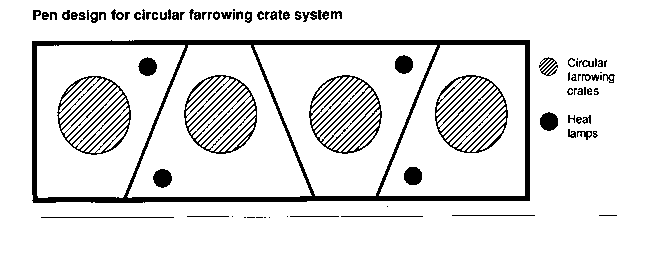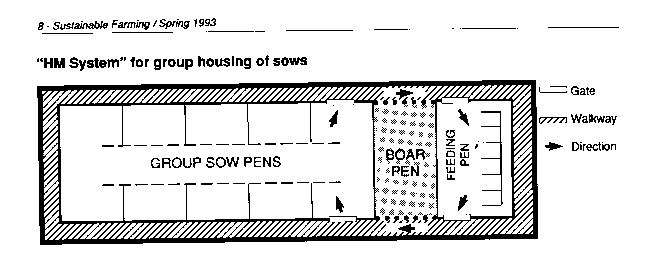
Sustainable Farming Index | Virtual Library | Magazine Rack
Search
| Ecological Solutions Roundtable
Uncommon design shapes up as housing solution
by Hugh Maynard
As pressure mounts from radical animal rights groups to ban livestock agriculture altogether, work is also progressing on alternative means of housing and handling farm animals. While no amount of re-design in livestock facilities intended to enhance the welfare of production animals will ever satisfy some activists, the development work on new housing systems is aimed at maximizing the animals' well-being without sacrificing performance.
Having already carried out trials with more open housing units for laying hens (see SF, Winter 1991), Frank Hurnik has now turned his attention to housing for sows. Professor of Animal and Poultry Science at the University of Guelph, Hurnik has collaborated to develop a circular farrowing crate with graduate student Zhenseng Lou, and a system of group housing that eliminates the constraining nature of the traditional rectangular gestation crate with colleague Jim Morris.
Following contours
"The circle is not a common shape in the barn," says Hurnik, noting that it is often a difficult structure to manage or wastes precious space. The main benefit of a circular farrowing crate is that it allows the sow movement during the 3-4 week nursing period but also keeps the original advantage - preventing piglets from being crushed.
While the circular design of the crate is closer to the natural contour of a sow while lying down and allows her to turn around, both important features in achieving the objective of improved welfare, the re-arrangement of the surrounding pen walls (see diagram) has been critical to maintaining space efficiency and simplified management.
By off-setting the dividing bars between pens, space utilization is optimized and management functions such as cleaning and piglet monitoring remain efficient and accessible. The pens are mounted on a raised platform ten inches above the concrete floor; the platform is perforated for drainage and covered in plastic. The circular "containers" still take up more space than conventional ones - four circles in the space of five rectangles - but Hurnik believes this is an acceptable compromise in light of the improved physical and psychological conditions for the sows.
"The sow can turn around and can monitor the piglets, there is less frustration and the sows seem calmer. We have found it a step forward over the old crates," Hurnik explains.

Stanchion-less
The ease of feeding, cleaning and managing sows in stanchions, or gestation crates, has been their biggest appeal. But the lack of exercise in this type of housing system has been identified as the cause of leg problems in sows, higher culling rates and a general reduction in the longevity of breeding stock.
Hurnik has focused on adapting the management strategy for gestating sows in a group setting as a means for eliminating the necessity of using crates. The HM System (after Hurnik and Morris) is designed to manage gestating sows in groups of six and combines computerized technology and animal psychology to provide a better all-round living environment for the animals.
"Group housing solves some problems but generates others," notes Hurnik, mentioning the traumatic experience for sows of being re-introduced to a group pen after farrowing - the "group hierarchy adjustment" that results in bullying, biting and the general scrapping that goes on to determine which sow will be 'top dog' in the pen.
The traditional solution has been to separate the sows into individual crates with a free-roaming boar for heat detection. Hurnik has reversed that approach, establishing "stable social groups" of six sows that are housed together throughout their breeding life, being re-united after each farrowing. The sow pens have been designed as living quarters only, with access to water and an area for manure. The sows leave the pen to feed (see diagram) in a separate feeding area, passing the boar both on the way there and back.
"They remember each other even after six weeks," says Hurnik about the return to group life, noting that aggression between sows is markedly reduced. He acknowledges that some pen fighting has to be accepted as sows are culled early and replacements introduced; but Hurnik also notes that synchronized breeding is facilitated because the sows respond well when passing the boar, enabling movement out of the pen for farrowing as a group.

Feeding stress
Another source of tension in group housing is feeding time, a daily fight over a restricted resource that is common even when computerized feeders have been introduced to group pens.
"Computer feeding was a step-forward in electronics but the engineer did not understand animal behaviour," remarks Hurnik. His solution is to feed the six sows in each pen at the same time; instead of having six pens with one individual computerized feeding station in each, there is one feeding pen with six stations.
This system eliminates the fighting over feed between individual sows as each knows that whether they get there first or last, feed will be available for them. As well, because the pens go in a relay one after the other, the sows in the other pens do not become anxious and make the over-bearing noise commonly associated with feeding time in a hog barn.
"There is no noise at feeding because the other pens have no reason to associate the farmer's presence with feed," says Hurnik. He adds that the computerized system costs no more than a mechanical one and the HM system also produces savings in labour and replacement costs for sows.
"I believe we can do many things to improve animal welfare and economic performance by searching for technologies that benefit both," he concluded.
Poultry Update
Since experimenting with 'open' housing for laying hens that replaced the cages with a larger pen that has a group feeding area and individual nesting boxes, Hurnik has made refinements to further improve the system.
Because the system uses group nests, the hens have been inclined to eat the eggs during the night. To prevent this, the hens now cannot stay in the nesting areas overnight, being forced to roost outside the nest by a gate, swinging up on a pivot bar, which prevents re-entry until daytime.
Hurnik reports that this adjustment, along with access to the group area for feathering and preening, has allowed de-beaking to be discontinued. He notes that the provision of "occupational opportunities", as important for animals as for humans, has eliminated the boredom that instigated such vices as pecking, as well as the de-beaking necessary to halt the destructive nature of these type of activities.
Copyright © 1993 REAP Canada
Reprinted with permission. All rights reserved.
Info Request | Services | Become EAP Member | Site Map
Give us your comments about the EAP site
Ecological Agriculture Projects, McGill University (Macdonald
Campus),
Ste-Anne-de-Bellevue, QC, H9X 3V9 Canada
Telephone:
(514)-398-7771
Fax:
(514)-398-7621
Email: info@eap.mcgill.ca
To report problems or otherwise comment on the structure of this site, send mail to the Webmaster